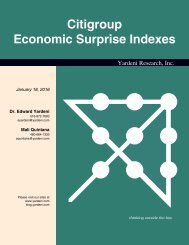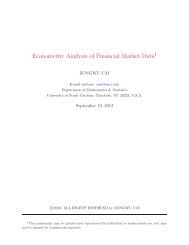Illiquid Asset Investing 1. Liquidating Harvard
Illiquid Asset Investing 1. Liquidating Harvard
Illiquid Asset Investing 1. Liquidating Harvard
You also want an ePaper? Increase the reach of your titles
YUMPU automatically turns print PDFs into web optimized ePapers that Google loves.
Andrew Ang <strong>Illiquid</strong> <strong>Asset</strong> <strong>Investing</strong> <strong>Asset</strong> Management<br />
<strong>1.</strong> By setting a passive allocation to illiquid asset classes, like real estate;<br />
2. By choosing securities within an asset class that are more illiquid, that is by engaging in<br />
liquidity security selection;<br />
3. By acting as a market maker at the individual security level;<br />
4. By engaging in dynamic strategies at the aggregate portfolio level.<br />
Economic theory states that there should be a premium for bearing illiquidity. 19 Theory also<br />
states that the premium can be large or small. It is perhaps surprising that the premium for<br />
illiquidity could be small. 20 In models where illiquidity risk has small or no effect on prices,<br />
illiquidity washes out across individuals. A particular individual may be affected by illiquidity –<br />
illiquidity can crimp his consumption, or affect his asset holdings (as in the asset allocation<br />
model with illiquidity risk I present below) – but other agents will not be constrained, or they<br />
trade at different times. Different agents share risk among themselves, which mutes the impact of<br />
illiquidity. Thus, in equilibrium the effects of illiquidity can be negligible. 21<br />
Whether the illiquidity risk premium is large or small is an empirical question.<br />
4.1 <strong>Illiquid</strong>ity Risk Premiums Across <strong>Asset</strong> Classes<br />
Figure 5 is from Antti Ilmanen’s (2011) wonderful book, Expected Returns, and plots average<br />
returns on illiquidity estimates. The average returns are computed from (reported) data over 1990<br />
to 2009. The illiquidity estimates represent Ilmanen’s opinions. Some private equity investments<br />
are more liquid than certain hedge funds, and some infrastructure investments are much less<br />
19<br />
This large literature begins with a seminal contribution by Demsetz (1968). See summary articles by Hasbrouck<br />
(2007) and Vayanos and Wang (2012).<br />
20<br />
Lo, Mamaysky and Wang (2004) and Longstaff (2009), among others, argue that the illiquidity premium should<br />
be large.<br />
21<br />
For models of this kind, see Constantinides (1986), Vayanos (1998), Garlenau (2009), and Buss, Uppal and<br />
Vilkov (2012).<br />
20




